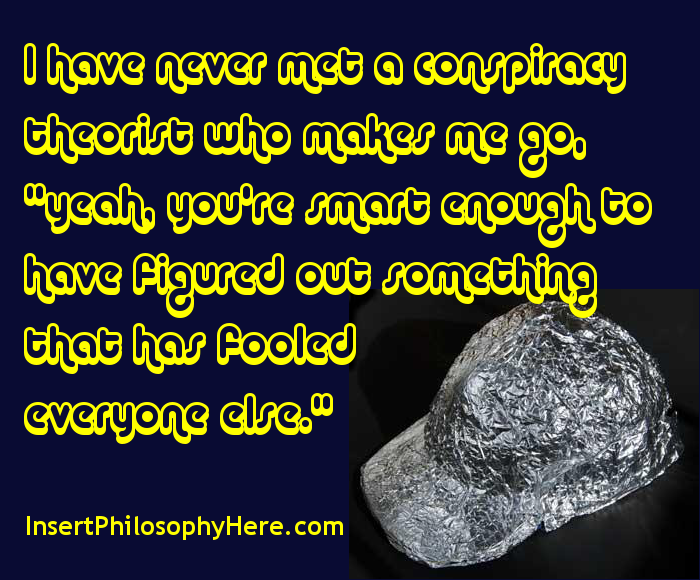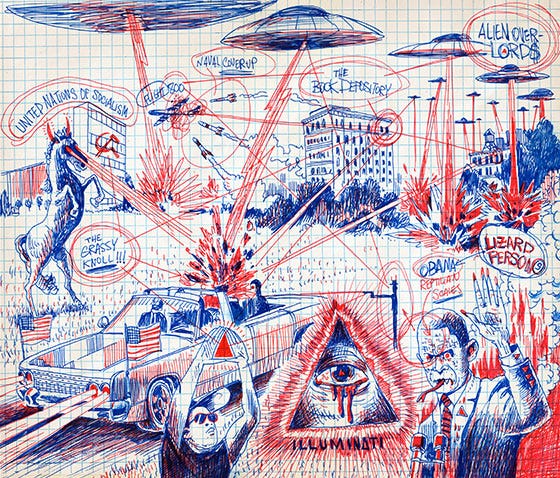 |
| https://neurosciencenews.com/truth-relativism-conspiracy-theories-23896/ |
A Sense of Doubt blog post #3151 - What Lurks Beneath Conspiracy Theories
Just a share today.
Thanks for tuning in.
Conspiracy theories are part of human culture, and we cannot just dismiss them.
Some people, despite all proof to the contrary, believe the moon landings were faked. Some people, despite all proof to the contrary, believe the last election was stolen. And those are just two of the many conspiracy theories that are believed by untold numbers of people.
How can we understand the phenomena of conspiracy theories? Conspiracy theories conjure up stories about grassy knolls, UFO cover ups, the Illuminati, and other wild ideas that most people consider to be nonsense. The people who believe them aren’t all asylum inmates wearing tin foil hats in fear of government mind control. Conspiracy theories are part of human culture. We cannot just dismiss them, if for no other reason than we can’t ignore the damage caused by conspiracy theories. We are seeing the deaths of thousands of people who believed conspiracy theories about the COVID-19 pandemic.
To ignore or ridicule beliefs in conspiracy theories is to be as dismissively arrogant as the conspiracy theory believers are about beliefs other than their own. We don’t have to agree with the conspiracy theories, but we need to understand what they are, why some people believe them, and what lurks beneath them.
A Definition of Conspiracy Theories
What are conspiracy theories, and why are they so common? First, we need to define what we are analyzing.
Conspiracy Theory: A claim that you have figured out a secret that “normal” people have not.
There are three components of this definition.
One: Conspiracy theories are stories about secret cabals secretly meeting in secret places to secretly concoct secret plans. And yes, I stress the secret aspect of these stories. For a story to appeal to those who believe in conspiracy theories, it has to be about a deep, dark secret. By definition, a conspiracy is a secretive plot, but a conspiracy theory is about some seriously hidden, seriously dark skullduggery being brought to light.
Two: A conspiracy theory is a truth claim. This fact is often ignored but is very important. People believe a conspiracy theory because they believe it is true. No matter how weird beliefs might be, every idea we hold to be true is a belief we feel we are justified in having. It is no different for those who believe in conspiracy theories that others dismiss as wacky nonsense. What makes conspiracy theories different from other beliefs is that the rules of truth are different. It is more than a sense of lowering the standards of evidence. Believing a conspiracy theory comes from thinking differently about reality leading to different beliefs about what is true. More on that later.
Three: Conspiracy theorists, because they believe different truth claims, think of themselves as different from “normal” people. Conspiracy theorists have figured out secret truths that the rest of us have not. Believers in a conspiracy theory claim to have “knowledge” about seriously hidden, seriously dark skullduggery. Their “knowledge” sets them apart from the masses (that’s you and me) who are “still duped” by the conspiracy.
The Three Dimensions of a Conspiracy Theory
Every conspiracy theory has those three components in varying degrees. There are also three dimensions to every conspiracy theory: paranoia, arrogance, and cliquishness. — Read the rest on Medium
https://medium.com/original-philosophy/what-lurks-beneath-conspiracy-theories-a3801895d412
INSERTING PHILOSOPHY INTO REAL LIFE
What Lurks Beneath Conspiracy Theories?
Conspiracy theories are part of human culture, and we cannot just dismiss them.
A shorter video version for those who like images:
An extended text version for those who like text:
Some people, despite all proof to the contrary, believe the moon landings were faked. Some people, despite all proof to the contrary, believe the last election was stolen. And those are just two of the many conspiracy theories that are believed by untold numbers of people.
How can we understand the phenomena of conspiracy theories? Conspiracy theories conjure up stories about grassy knolls, UFO cover ups, the Illuminati, and other wild ideas that most people consider to be nonsense. The people who believe them aren’t all asylum inmates wearing tin foil hats in fear of government mind control. Conspiracy theories are part of human culture. We cannot just dismiss them, if for no other reason than we can’t ignore the damage caused by conspiracy theories. We are seeing the deaths of thousands of people who believed conspiracy theories about the COVID-19 pandemic.
To ignore or ridicule beliefs in conspiracy theories is to be as dismissively arrogant as the conspiracy theory believers are about beliefs other than their own. We don’t have to agree with the conspiracy theories, but we need to understand what they are, why some people believe them, and what lurks beneath them.
Many people conflate two different social phenomena, Here is a clarification:
A Definition of Conspiracy Theories
What are conspiracy theories, and why are they so common? First, we need to define what we are analyzing.
A Definition:
Conspiracy Theory: A claim that you have figured out a secret that “normal” people have not.
There are three components of this definition.
One: Conspiracy theories are stories about secret cabals secretly meeting in secret places to secretly concoct secret plans. And yes, I stress the secret aspect of these stories. For a story to appeal to those who believe in conspiracy theories, it has to be about a deep, dark secret. By definition, a conspiracy is a secretive plot, but a conspiracy theory is about some seriously hidden, seriously dark skullduggery being brought to light.
Two: A conspiracy theory is a truth claim. This fact is often ignored but is very important. People believe a conspiracy theory because they believe it is true. No matter how weird beliefs might be, every idea we hold to be true is a belief we feel we are justified in having. It is no different for those who believe in conspiracy theories that others dismiss as wacky nonsense. What makes conspiracy theories different from other beliefs is that the rules of truth are different. It is more than a sense of lowering the standards of evidence. Believing a conspiracy theory comes from thinking differently about reality leading to different beliefs about what is true. More on that later.
Three: Conspiracy theorists, because they believe different truth claims, think of themselves as different from “normal” people. Conspiracy theorists have figured out secret truths that the rest of us have not. Believers in a conspiracy theory claim to have “knowledge” about seriously hidden, seriously dark skullduggery. Their “knowledge” sets them apart from the masses (that’s you and me) who are “still duped” by the conspiracy.
The Three Dimensions of a Conspiracy Theory
Every conspiracy theory has those three components in varying degrees. There are also three dimensions to every conspiracy theory: paranoia, arrogance, and cliquishness.

The “they are out to get me” dimension
The long history of conspiracy theories is rooted in human paranoia about what lurks beyond what can be readily seen and heard. Concern about potential threats to our well-being is prudent. Obsessions with potential threats can be harmful. “The boogeyman” does not exist except in the minds of those who fear him, and it is the fear itself that causes harm. Nevertheless, fear frequently outweighs sense and proportion, and the human imagination takes over. The “they are out to get me” dimension of conspiracy theories results from paranoia taking over.
The boogeyman manifests in a wide range of conspiracy theories. Hatred and fear of people who are different is the leading cause of beliefs in conspiracy theory boogeymen. Jews, Catholics, and Muslims have long been targets of suspicion. The fraudulent document, Protocols of the Elders of Zion, is a classic example of the “they are out to get me” conspiracy theory. The story of a secret cabal of Jews with a secret plot to overthrow the crown heads of Europe was concocted about 1903. It was an early version of what we now call “fake news.” The Protocols conspiracy theory was, and still is, used by bigots to inflame hatred against Jewish people. Other fictitious world domination conspiracies are attributed to The Illuminati, the Freemasons, the Deep State, and similar groups, fictitious and real. There is little evidence that any of these conspiracies exist, but the conspiracy theorist simply claims that the secret cabals are good at covering up evidence.
The “I know something you don’t” dimension

Imagine I have a box. I tell you that I know that there is something incredible in the box, but I can’t show it to you. You would laugh and walk away. The conspiracy theorist is not acting much differently. He knows something you don’t, but he cannot show it to you because it is a secret. (I use “he” because conspiracy theorists are overwhelmingly males.) Conspiracy theories are stories about what lurks beyond what can be readily seen and heard. On that blank canvas of the unknown, human imagination can flourish. Highly imaginative conspiracy theories spring up that tell us that something sinister is happening someplace we cannot see. The imaginative story can persist because it’s about something that cannot be perceived, and the theory cannot be easily refuted.
Such conspiracy theories include stories about pedophile rings in pizza parlors, that there are alien bases on the dark side of the moon or under the ice of Antarctica, that the Earth is hollow, that the government has a secret space fleet, and they have a crashed UFO at Area 51, and so on. You haven’t been there, so you don’t know otherwise. It’s surprising there aren’t any conspiracy theories that the ocean is bottomless because most people have never been to the seafloor.
Anyway, beyond geography, any unknown or lesser-known occurrence sprouts conspiracy theories. Celebrity deaths spawn competing claims that the death was faked or caused by nefarious forces. Government activities done out of the sight of the public get attributed to them nefarious intent. If there is a mystery, conspiracy theories about it will spring up to fill the gap in knowledge. A grim example of how imagination and opportunists fill in the unknown are the conspiracy theories that arose to explain the disappearance of flight MH370, as explained very well in this article by William Langewiesche.
The conspiracy theorist claims to have figured out a secret that “normal” people have not. How it is that the conspiracy theorist knows these secrets is never adequately explained. Shadowy “insider sources” are cited, and when a former “insider” is quoted, his or her claims cannot be verified. Always, it circles back to “it’s a secret that I know but you don’t.” The conspiracy theorists know what is in the box, but they cannot show you. You just have to believe them. They are smarter than you, you know.

The “join the believers’ club” dimension
Cliques don’t just exist in high school. If you believe in a conspiracy theory, you get to join a special club of fellow believers. This is largely human nature. People enjoy communing with others who share their interests. If you collect a thing, you can find others who collect the same thing. If you collect rumors about a particular conspiracy theory, you can find others who do the same.
In a conspiracy theory community, you join more than a fan club. You join a distinct subculture. Depending on the nature of the conspiracy theory, believers in the subculture feel varying degrees of separation from mainstream society. Conspiracy theories centered on a “they are out to get me” story, can create subcultures that are insular and hostile to others. And if you don’t believe their theory, well, you may be part of the conspiracy.
What unites conspiracy theorists is a shared sense of accomplishment. The conspiracy theorists believe they “know” about what is really going on while others remain in the dark. The conspiracy theory believers have joined a special group of enlightened people who now have superior understanding that separates them from the “sheeple” who are still in the dark, fooled by the conspiracy. Joining a conspiracy theory can be more than agreeing with a belief — it can be a sense of identity for people. More on that later.
Why do people believe in conspiracy theories?
We can start to see why conspiracy theories are attractive. We have seen three reasons already: fear of the unknown, feeling accomplishment in knowing a secret, and connection with others who believe the conspiracy theory. There are more reasons people choose to believe in conspiracy theories, the two main ones being a search for meaning and a search for profit.
There are two kinds of conspiracy theorists who have different objectives: earnest meaning seekers and con artists.
Earnest meaning seekers
Granted, normal is boring, but some people turn to fantasy to spice things up. Many conspiracy theories are little more than fantasies. The world is an amazing and fascinating place, but some people feel the need for more. Those Mayan pyramids are amazing. Some people want to believe they are even more amazing — they were built by aliens. Similarly, some want to believe Elvis didn’t die; he faked his death and lived on in secret. COVID isn’t natural; it was genetically engineered in a lab. And so on. Believing these stories makes the world more interesting.
Believing that “they are out to get me” can give the believer a sense that one is special. “The government is spying on me,” says the conspiracy theorist, “they are afraid of me,” implying that he is important enough for shadowy cabals to spend time and effort on him. It gives some meaning to an otherwise bland and ordinary life. Another way to manufacture a feeling that one is special is to believe one has cracked a conspiracy. “I figured that out, I am smarter than them.”
Some conspiracy theory fantasies are harmless. Belief that the government is covering up bigfoot sightings probably isn’t going to hurt anyone. Other conspiracy theories that have political dimensions are less benign. People seek, in conspiracy fantasies, to replace their feelings of impotence and isolation with a more preferable and simplistic story that gives them a sense of certainty. For some, it is preferable to believe that Barack Obama was born in Kenya than that he is an American like them. For some, it is preferable to believe that 9–11 was an inside job than that the U.S. simply failed at defending itself. For some, it is preferable to believe that a shadowy cabal interfered in an election than that their candidate simply lost.
Being willing to hold such fantasies of sinister cabals inclines one to fall prey to con artists.
Con(spiracy) Artists
Meaning seekers can be seduced by con artists. A con(spiracy) artist is a con artist whose con is being a professional conspiracy theorist. Through Web sites, books, television and radio shows, and lectures they sell conspiracy theories as products. They have figured out a secret that “normal” people have not. They know what is in the box. You can hear about it if you buy the book, buy a subscription to the podcast, and so on. The con(spiracy) artist sells an attractive fantasy. Well, attractive to a certain type of earnest person seeking a particular type of meaning that dumbs down the complexity of reality and replaces it with false certainty that a conspiracy theory is true.
The granddaddy of today’s conspiracy theory con men is Erich Von Daniken. His 1968 book Chariot of the Gods? was a bacchanalia of bad science and fallacious reasoning. His fantasy that an alien civilization or civilizations intervened as gods in ancient human civilizations has spawned a whole industry of con(spiracy) artists claiming to tell us what the experts are keeping secret. In the 1970s, Zachariah Sitchen invented a fantasy of the extraterrestrial origin myth for humanity (aliens created us), wisely choosing to base the fantasy on a group of minor Sumerian deities barely mentioned in ancient sources. Sitchen told people he knew what was in the box, even though no one else could see it. Perfect con. Today, the ancient aliens con job is spearheaded by Giorgio Tsoukalos (below)

who has great suits and great hair and a now 11-year-long television show, Ancient Aliens, peddling every wacky alien theory he can get his hands on. The show is slick and entertaining, mainly from the humor of its outlandish leaps of logic.
I mention UFOs and aliens conspiracy theories because they are a gateway into more hardcore political conspiracy theories. Aliens and UFOs are a prolific con(spiracy) artist genre. Fantasies about aliens readily connect with conspiracy theories about sinister government forces covering up all kinds of secrets. X-Files’s stories of a deeply hidden government/alien conspiracy was fiction, but some people don’t realize that.
It is no coincidence that radio shows like Coast to Coast AM give platforms to con(spiracy) artists selling stories about aliens and the paranormal alongside con(spiracy) artists selling stories that “the government is out to get you.” On right-wing radio and podcasts, you can hear stories about the U.S. secret space program that has military bases all over the solar system, central banks are going to take all of your money, Atlantis is under Antarctica, gays are coming for your children, and The Illuminati have been poisoning the food supply with fluoride. (Fluoridation as a conspiracy is an old story. No, Dr. Strangelove didn’t make it up.) There is no shortage of con artists selling these and similar theories.
Political Con(spiracy) Artists
Ancient alien con artists push the conspiracy theory that science suppresses archaeology. That is mostly harmless — just bilking people out of money. Far more malicious are the “government is out to get you” con(spiracy) artists. In this dark realm, the stories are nastier and powered by bigotry against particular groups of people. These conspiracy theories can inspire violence, such as storming capital buildings. Political conspiracy theories come in varying levels of virulence based on the subject of the theory.
Many people use conspiracy theories to express bigotry. The Nazis peddled the communist conspiracy and Jewish conspiracy theories to stoke violence and justify their dictatorship. Southern U.S. white supremacists spread conspiracy theories about civil rights to keep minorities suppressed. The Soviets and the U.S. both spread conspiracy theory propaganda during the Cold War to stoke xenophobia and justify militarism.

The “red menace” or “international communist conspiracy” is a typical political conspiracy theory. Pushed by con(spiracy) artists such as Charles Coughlin, Joseph McCarthy, James Eastland, Lyndon LaRouche, and a plethora of right-wing radio talking heads, these con men made political or commercial careers peddling theories of communist conspiracies. “Communists are coming to steal your freedoms” was the constant refrain of the con(spiracy) artists. After the Soviet Union fell, new boogeymen were targeted. Now gays, environmentalists, feminists, and basically everyone else more liberal than the con(spiracy) artist are branded as conspirators against “freedom” who are “out to get me, you, and your little dog, too.” A recent incarnation of this political con job is QAnon: a fake person spewing fake news to stir up real hatred.
Cultivating fear of the boogeyman has been a common political propaganda tool. Authoritarian governments, paramilitary groups, cult leaders, and others have used conspiracy theories to manipulate others. Shady operators have used the same manipulative techniques to make money off of other people’s fears. For example, con(spiracy) artists leading the anti-vaccine movement sell falsehoods about the safety and effectiveness of vaccines. Their con game is that liberal governments and scientists “are out to get you” with the vaccines. The con(spiracy) artists tell people to ignore everything the government says. “Be afraid and send us money and we will tell you how to protect yourself.” Those con artists make money selling lies that have killed thousands worldwide.
Political conspiracy theories are effective at manipulation because they give believers a sense of identity. People can define themselves in terms of opposition to the conspiracy. They can view themselves as brave people defending themselves from evil plotters. In some conspiracy theory communities, a near cult-like environment takes hold as described by this woman in her experiences with anti-vaccine groups and by these people who escaped the QAnon conspiracy theory. Dedicated organizations like a political party or lobbying group can exploit the fear generated by a conspiracy theory to strengthen loyalty to the group or cause.
Conspiracy Theories and the Internet Age
Conspiracy theories are more common and widespread than ever. The Internet has catalyzed and concentrated conspiracy theories, providing forums for conspiracy theorists to gather and spread stories and fantasies. Anyone can post a conspiracy story or fantasy which potentially could be seen within minutes by hundreds or thousands all over the world. The online world also strengthens conspiracy communities. Internet sites and forums create communication silos or echo chambers in which one hears no other voices. Followers of a conspiracy theory can speak with each other isolated from those who are “out to get us.” Absolutist claims and conspiracy theories not only go unchallenged but receive only “likes” and “hell yeahs.” By speeding the spread of propaganda and allowing users a privileged sense in their consumption and sharing of information, the online world intensifies the three dimensions of conspiracy theories (“they are out to get us,” “I know something you don’t,” and “join the believers’ club”).
In the 2010s, YouTube became a hot spot for conspiracy theories. Side by side you could watch videos about bigfoot; UFOs; scientists hiding evidence of ancient civilizations; the world is flat; the world is hollow; JFK was killed by them, them, and the other people; world leaders are really lizard people; Obama is Kenyan, Russian, alien; the government is poisoning us, wants to imprison us, wants to take away guns, is trying to make us gay, is faking mass shootings, is lying to us about this, that, and the other thing; oh, and Blacks/Jews/gays/Muslims/commies/unions/feminists/immigrants are out to get us.

Alex Jones was the king of the YouTube conspiracy brigade and one of the leading political con(spiracy) artists. Through unintentionally hilarious videos and podcasts, Jones channels Charles Coughlin’s fascism and xenophobia and updates it for the Internet age. Jones never met a right-wing conspiracy theory he would not repeat. Most notoriously, he mindlessly repeated the “pizzagate,” David Icke reptilian, and “Sandy Hook massacre was a hoax” fantasies. YouTube has since removed con(spiracy) artist Alex Jones from its site, but Jones remains the vanguard for right-wing “they are out to get us” con(spiracy) artists online, making millions selling conspiracy porn to earnest meaning seekers.
Social media, despite its ability to connect with anyone anywhere, is predominantly used by people to commune only with those with whom they agree. Conspiracy theories are a rallying point for political activism. Because political activity today is more antagonistic toward others than supportive of one’s own side, conspiracy theories are lubricant for political speech. Creating conspiracy memes online is now almost an occupation for political groups. They are also political weapons. Before the 2016 election, both Hillary Clinton and Donald Trump supporters circulated stories that the other side would steal the election. That, after months of Hillary supporters spreading conspiracy theories that Bernie Sanders was a plant placed to sabotage Hillary’s election. They called Bernie supporters Russian trolls long before they called Trump supporters Russian trolls. And Trump supporters are even worse with bigotry-driven conspiracy theories as the 2020 election cycle and the the January 6th attempt to overthrow the election result showed.
Both U.S. political parties are now completely obsessed with conspiracy theory thinking. The main difference is whether they place “Democrats” or “Republicans” in the sentence “the ____ are out to get us.” Con(spiracy) artists on both sides now dominate U.S. politics. And my pointing that out means I am declared by both Democrats and Republicans an “enemy” working for the other side. That is how conspiracy theories work.
The world of the conspiracy theorist

Conspiracy theorists think differently about reality. This makes their world a different world for them. Most of us take the world as it comes, and often to a fault take things at face value. The conspiracy theorist perceives the world through a filter of suspicion. They take the world as being full of deceit and malice. They may not believe the whole world is out to get them, but they believe a good chunk of it is. If you are not with the conspiracy theorists, then they will assume you are against them. Because you are against them, the conspiracy theorist is not interested in what you have to say. You are only trying to deceive them. The conspiracy theorist is always correct, and you are always wrong. We are all “enemy” to them.
Many are amazed at how tightly conspiracy theorists cling to their theories, despite all evidence to the contrary. That is because their belief in the conspiracy theory is more than a truth claim; it is an identity claim. Members of a conspiracy theory community define themselves in terms of opposition to the conspiracy. That sometimes means opposition to just about everyone and everything. Hence, the need for tin foil hats, metaphorical if not real, to keep everyone else and the real world at bay. As the old wisdom states, “the enemy of my enemy is my friend.” Sadly, that kind of hatred is a very strong social glue that factors into conspiracy theory communities.
It’s not populism; it’s conspiracy theorizing
What are incorrectly called “populist” movements are in actuality conspiracy theory communities. What unites supporters of Trump, Brexit, and nationalist parties are their beliefs in conspiracy theories. All three dimensions of conspiracy theories are there: “they are out to get us,” “we know something you don’t,” and “we are the united believers.” They “know” about the secret plans of the secret cabals of liberals/immigrants/Jews/Muslims/gays/and so on, and they are better than the corrupt and duped fools who don’t get it. Each movement is led by one or more con(spiracy) artists, and the movement is fleshed out with earnest seekers who find meaning in opposing the supposed conspiracies.
What ultimately lies behind conspiracy theories is the fear of the Other and the need to get back at those who are different. Believing a conspiracy theory gives one feelings of meaning, power, and belonging. These are normal and healthy human needs. It is also normal and healthy to be wary of external threats to our well-being. The most effective way for con artists to manipulate people is to exploit normal and healthy human tendencies. When fear outweighs sense and proportion, often caused by manipulation, belief in conspiracy theories takes hold.
Follow-up article:
— —
More reading:
Conspiratorial Ideation and Pathological Belief
The Truth Behind the Amazon Mystery Seeds — How a Conspiracy Theory Can Innocently Start
The Violent Crescendo of the MAGA Conspiracies
The Normalization of Conspiracy Culture
Taking Conspiracy Theories Seriously
The Truly Paranoid Style in American Politics (from 2013 but still accurate)
The Psychology of Conspiracy Theories
Alex Jones’ Mis-Infowars: 7 Bat-Sh*t Conspiracy Theories
Flat-Earthers Accidentally Prove the Earth Is Round

+++++++++++++++++++++++++++++++++++++++++++++++++++++++++++++++++++++++
+++++++++++++++++++++++++++++++++++++++++++++++++++++++++++++++++++++++
+++++++++++++++++++++++++++++++++++++++++++++++++++++++++++++++++++++++
- Bloggery committed by chris tower - 2310.04 - 10:10
- Days ago = 3015 days ago
- New note - On 1807.06, I ceased daily transmission of my Hey Mom feature after three years of daily conversations. I plan to continue Hey Mom posts at least twice per week but will continue to post the days since ("Days Ago") count on my blog each day. The blog entry numbering in the title has changed to reflect total Sense of Doubt posts since I began the blog on 0705.04, which include Hey Mom posts, Daily Bowie posts, and Sense of Doubt posts. Hey Mom posts will still be numbered sequentially. New Hey Mom posts will use the same format as all the other Hey Mom posts; all other posts will feature this format seen here.

No comments:
Post a Comment